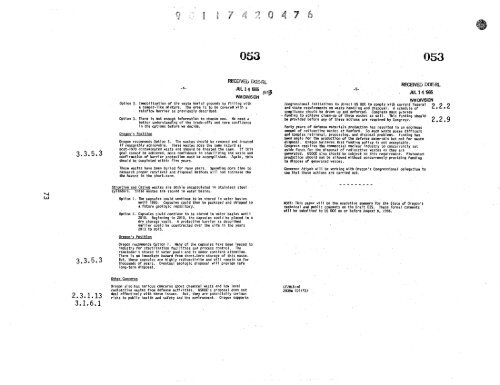EIS-0113_Section_9 - Hanford Site
EIS-0113_Section_9 - Hanford Site
EIS-0113_Section_9 - Hanford Site
You also want an ePaper? Increase the reach of your titles
YUMPU automatically turns print PDFs into web optimized ePapers that Google loves.
F<br />
f..<br />
WC 053<br />
3 .3.5.3<br />
RECEIVED DOE-RL<br />
- g - JUL I d 1986 a d<br />
WM DIVISION<br />
Option 2. Immobilization of the waste burial grounds by filling with<br />
a cement-like mixture. The area Is to be covered with a<br />
raInflow barrier as previously described.<br />
Option 3. There is not enough Information to choose now. We need a<br />
better understanding of the trade-offs and more confidence<br />
In the options before we decide.<br />
Oregon's Position<br />
Oregon recommends Option 3. The wastes should be removed and treated<br />
if reasonably achievable. These wastes pose the same hazard as<br />
past-1970 contaminated waste and should be treated the same. If this<br />
goal cannot be achieved, more confidence in stabilizing the waste and<br />
confirmation of barrier protection must be accomplished. Again, this<br />
should be completed within five years.<br />
These wastes have been buried for many years Spending more time to<br />
research proper retrieval and disposal methods will not Increase the<br />
the hazard In the short-term.<br />
RECEIVED DOE-RL<br />
JUL 14 1986<br />
WM DIVISION<br />
Congressional Initiatives to direct US DOE to comply with current federal O<br />
and state requirements on waste handling and disposal. A schedule of L 2 . 2<br />
compliance should be drawn up and enforced. Congress must provide<br />
- funding to achieve clean-up of these wastes as well. This funding should<br />
be provided before any of these actions are required by Congress '.<br />
2 . 2 . 9<br />
Forty years of defense materials p roduction has resulted in an enormous<br />
eminent of radioactive wastes at <strong>Hanford</strong>. So much waste poses difficult<br />
and tomplex retrieval, processing. and dis p osal p roblems. Funding has<br />
been ample for the production of the defense materials but not for waste<br />
disposal. Oregon believes. that funding policy is not acceptable.<br />
Congress requires the commercial nuclear industry to concurrently set<br />
aside funds for the disposal of radioactive wastes as they are<br />
generated. USOOE also should be subject. to this requirement. Plutonium<br />
production. should not be allowed without concurrently providing funding<br />
to dispose of generated wastes.<br />
Governor Atiyeh will be workingwith Oregon's Congressional delegation to<br />
see that these actions are carried out.<br />
V<br />
W<br />
Strontium and Cesium wastes. are double encapsulated in stainless steel<br />
cylinders. These wastes are stored in water basins.<br />
Option 1. The capsules could continue to be stored in water basins<br />
until 1995. Capsules could then be packaged and shipped to<br />
a future geologic repository.<br />
Option 2. Capsules could continue to be stored In water basins until<br />
2010. Beginning in 2010, the capsules could be placed in a<br />
dry storage vault. A protective barrier as described<br />
earlier could be constructed over the site In the years<br />
2013 to 2015.<br />
Oregon's Position<br />
NOTE: This paper will be the. executive summary for the State of Oregon's<br />
technical and public comments on the Draft <strong>EIS</strong>. These formal comments<br />
will be submitted to US WE on or before August 9. 1986.<br />
3.3.5.3<br />
Oregon recommends Option 1. Many of the capsules have been leased to<br />
Industry for sterilization facilities and process control. The<br />
'remainder's stored in water pools and Is under constant attention.<br />
There is no Immediate hazard from short-term storage of this waste.<br />
But, these capsules are highly radloactivite and will remain so for<br />
thousands of years. Eventual geologic disposal will provide safe<br />
long-tern disposal.<br />
2 .3.1.13<br />
3.1.6.1<br />
Other Concerns<br />
Oregon also has serious concerns about chemical waste and low level<br />
radioactive wastes from defense activities. USDOE's proposal does not<br />
deal effectivel y with these tSlm.S. But, they are potentially serious<br />
risks to public health and safety and the environment. Oregon Supports<br />
LFIX B:mi<br />
293% (OI1F2)

















